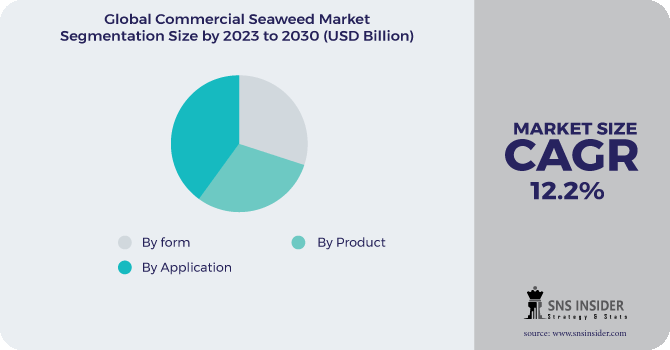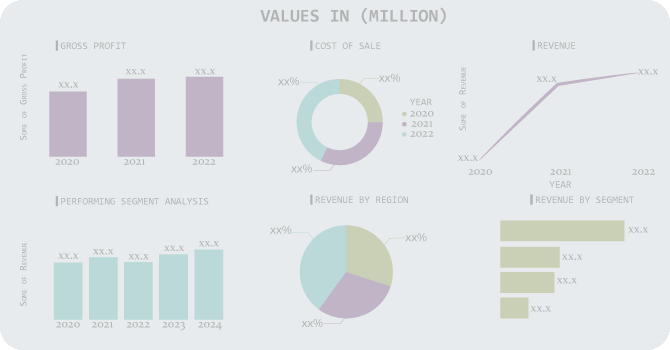Commercial Seaweed Market Report Scope & Analysis:
The Commercial Seaweed Market size is assessed to be esteemed at USD 21.03 billion by 2022 and is projected to arrive at USD 52.78 billion by 2030, recording a CAGR of 12.2% during the conjecture time frame, regarding esteem.
Seaweed is an umbrella term for a gathering of multi-cell, plainly visible, and marine green growth, which are found in different shades of red, green, and brown. They might be molded as fragile fingers, circles, or wide leaves, or may look like an organic product. Even though seaweed has been eaten for quite a long time as a critical wellspring of food, they are overall progressively utilized on a business level. They track down broad applications in the food and refreshments area for their hydrocolloid properties alongside a few applications in different ventures, including beauty care products, individual consideration, creature feed, added substances, agribusiness, and drugs.
.png)
Get More Information on Commercial Seaweed Market - Request Sample Report
Seaweed used as manure upholds the horticultural business by improving the result in restricted cultivable land to satisfy the developing food need. Since manageable farming practices are being prevented because of an enormous decrease in soil ripeness, there is a popularity for successful manures for expanded yield and food security. This thus will uphold commercial seaweed market extension during the assessment timetable.
Commercial seaweed has different kinds of full scale and miniature supplements in it, like magnesium, potassium, sodium, copper, zinc, calcium, sulfur, phosphorous, chlorine, and different supplements. There are around 221 types of commercial seaweed present, from which, the red and earthy colored commercial seaweed are broadly utilized. There are different kinds of commercial seaweed subsidiaries that are gotten, like carrageenan, agar, and alginate. From these, carrageenan is the broadly involved commercial seaweed subordinate in the food and refreshment industry because of its different properties as a hydrocolloid.
Market Dynamics:
Driving factors:
-
Ascend in seaweed cultivating rehearses impelled by worldwide interest.
-
Higher utilization of red ocean growth in the food business
Restraining factors:
-
Regular disasters prevent the creation of seaweed.
-
Inordinate utilization of kelp concentrates and the presence of harmful minerals prompt well-being concerns.
Opportunities:
-
Expansion in mechanical turns of events.
-
The interest for top-notch and normal enhancements.
Challenges:
-
Harmfulness is related to the utilization of seaweed.
-
Expanding water contamination because of the blending of harmful material synthetic substances and plastic from modern effluents.
Impact of Covid-19:
In 2020, the worldwide emergency covid19 has impacted the commercial seaweed market. Because of the conclusion of a few assembling units in this fragment, creation has diminished. As indicated by the United Nations industrial commercial organization, the pandemic has straightforwardly impacted seaweed ranchers as interest in unrefined components has diminished and costs have fallen. The cost of for the most part sending out cotton seaweed, utilized for creating carrageenan (an added substance used to thicken, emulsify, and safeguard food varieties and beverages), has declined by practically half since the exchange with China, which is the greatest product market. Further, many perceived associations in the area of medical care, for example, the world health organization have expressed that seaweed can battle covid. This has changed the purchaser's view of the seaweed and has expanded the interest in it at the same time.
Market Estimation:
Given the type, the market is bifurcated into brown seaweeds, green seaweeds, and red seaweeds. The red seaweed fragment is supposed to hold the biggest piece of the pie. The variables can be credited to their amazing practical traits, fluctuated application scope, and simple accessibility.
In light of application, the market is bifurcated into agriculture, feed, food, and others. Dairy items are anticipated to hold the main CAGR in the gauge period as seaweed extricates are utilized as a thickening and gelling specialist in items, for example, cheddar, creams, pastries, frozen yogurts, dairy powder, and dairy drinks.
In light of form, the market is bifurcated into flakes, liquid, and powder. The chips are expected to hold the biggest piece of the pie. The elements can be credited for their developing use as salt substitutes and preparing specialists.
Key Market Segmentation:
By product:
-
Brown seaweeds
-
Red seaweeds
-
Green seaweeds
By application:
-
Agriculture
-
Animal feed
-
Human consumption
-
Others
By form:
-
Liquid
-
Powdered
-
Flakes

Get Customized Report as per Your Business Requirement - Request For Customized Report
Regional analysis:
-
North America
-
The USA
-
Canada
-
Mexico
-
-
Europe
-
Germany
-
The UK
-
France
-
Italy
-
Spain
-
The Netherlands
-
Rest of Europe
-
-
Asia-Pacific
-
Japan
-
south Korea
-
China
-
India
-
Australia
-
Rest of Asia-Pacific
-
-
The Middle East & Africa
-
Israel
-
UAE
-
South Africa
-
Rest of Middle East & Africa
-
-
Latin America
-
Brazil
-
Argentina
-
The rest of Latin America
-
Given local investigation, the global commercial seaweeds market is grouped into north America, Europe, Asia Pacific, and the rest of the world. The biggest offer in the market will be overwhelmed by the Asia pacific attributable to the huge scope creation and homegrown utilization of palatable seaweed around here.
Key Players:
Major key players included are Roullier group, biostadt India limited, compo gmbh & co. Kg, Acadian Sea plants limited, gelymar SA, Brandt consolidated, inc., season international pty. Ltd., cp kelco., west coast marine bio-processing corp., leili group.
Roullier group-Company Financial Analysis

| Report Attributes | Details |
|---|---|
| Market Size in 2022 | US$ 21.03 Billion |
| Market Size by 2030 | US$ 52.78 Billion |
| CAGR | CAGR 12.2% From 2023 to 2030 |
| Base Year | 2022 |
| Forecast Period | 2023-2030 |
| Historical Data | 2020-2021 |
| Report Scope & Coverage | Market Size, Segments Analysis, Competitive Landscape, Regional Analysis, DROC & SWOT Analysis, Forecast Outlook |
| Key Segments | • by product (brown seaweeds, red seaweeds, green seaweeds) • by Form (Liquid, Powdered, Flakes) • by application (Agriculture, Animal feed, Human consumption, Others) |
| Regional Analysis/Coverage | North America (USA, Canada, Mexico), Europe (Germany, UK, France, Italy, Spain, Netherlands, Rest of Europe), Asia-Pacific (Japan, South Korea, China, India, Australia, Rest of Asia-Pacific), The Middle East & Africa (Israel, UAE, South Africa, Rest of Middle East & Africa), Latin America (Brazil, Argentina, Rest of Latin America) |
| Company Profiles | Roullier group, biostadt India limited, compo gmbh & co. Kg, Acadian Sea plants limited, gelymar SA, Brandt consolidated, inc., season international pty. Ltd., cp kelco., west coast marine bio-processing corp., leili group. |
| Key Drivers | •Ascend in seaweed cultivating rehearses impelled by worldwide interest. |
| Restraints | •Regular disasters prevent the creation of seaweed. |

